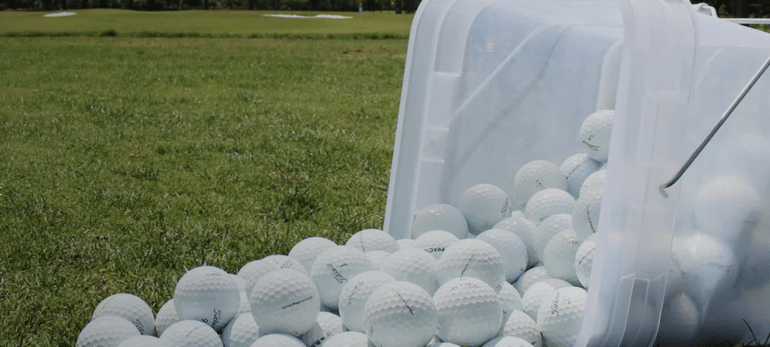While golfers know they need good skills to play well, they also know that they can't excel without the proper equipment. Of course, golfers need to find the right clubs, but they must also give equal attention to finding the right golf balls. All aspects of their game are affected by the balls they use, and quality, affordable golf balls can make the difference between an average round and an outstanding one. When they choose their golf balls, golfers need to consider several crucial factors.
Buying New or Recycled Golf Balls
Quality golf balls don't have to be prohibitively expensive. Golfers who buy recycled golf balls can get nearly the same performance as they would from new ones while paying a greatly reduced price. New golf balls are notoriously expensive now, and their cost will undoubtedly continue to rise. Experts note that golfers can pay up to $4 or more for a single new golf ball. For many people, buying a quantity of quality balls at that price is not financially practical. Golfers do not want to limit their rounds based on the price of golf balls, but they may have to unless they embrace an alternative choice.
Businesses such as Lostgolfballs.com recycle golf balls and sell them at greatly reduced prices, between 50 to 80 percent of the original cost. This means golfers can spend a dollar or two for premium golf balls in mint, near-mint or good condition, saving up to $2 on each ball. For an avid golfer, these savings rapidly add up.
Golfers may worry that they will be stuck with a limited selection when they buy recycled balls. In fact, golfers do not give up choice when they reject the cost of brand new balls. At Lostgolfballs.com, they can purchase brands such as Titleist Pro V1 or ProV1x, Callaway Chrome Soft and Taylor Made TP5x, among other top names. They will receive the benefits of cutting-edge technology for very little money.
Additionally, golfers don't give up performance when they choose recycled balls. Independent research shows that the differences between golf balls from lostgolfballs.com and new golf balls are "negligible." In fact, recycled golf balls may improve a golfer's game because they can play more rounds without incurring outrageous costs.
Finding the Right Golf Ball
Finding affordable golf balls is not enough. Golfers also need to purchase the type that works best for their game. They can find the right golf balls by using the online tool at Lostgolfballs.com. By completing five simple steps, players can identify the best balls based on several factors. The tool asks about their swing speed, which is determined by their average drive distance. Golfers will also input their golf ball brand preference, such as Bridgestone, Callaway, Nike, Titleist, etc.
Finally, golfers must state their most important goal: accuracy, control or distance. After they complete these questions, the online tool calculates the best brands for the individual golfer, all of which are available for purchase on the website. This feature works for golfers of all ability levels, from beginners to scratch players, and helps to remove the guesswork from golf ball shopping.
Evaluating Golf Ball Construction
Before making their final choices, golfers should evaluate a golf ball's construction, including its compression and how the core and cover affect distance and control. In general, golfers choose between two-piece and three-piece golf balls. Both types offer different benefits to golfers of varying abilities.
The two-piece golf ball has a thin cover and a solid core in order to produce long distances and low spin. The ball will not stop quickly on the green, but the player can expect less hooking and slicing. This type of ball works best for novices and other less-advanced players.
In contrast, the three-piece (and sometimes four-piece) golf ball has a soft core and a soft cover. It will also have one or two inner layers that add to the ball's control level. These golf balls are usually chosen by experienced golfers with a low handicap. Examples of this type of ball include Bridgestone e6.
Golfers should also consider compression when choosing balls. The higher the level of compression, the denser the golf ball. Balls with low compression ratings of 70 or 80 are meant to give greater distance to beginning and junior golfers. Advanced golfers will choose balls with a compression rating of 90 or above. They offer less distance but superior control.
Final Thoughts
In summary, golfers can improve their game by understanding which golf balls suit their style and level of play. The information at Lostgolfballs.com can help golfers find excellent recycled golf balls that enhance their game while saving them money. The site's online tool makes recommendations based on swing speed, golfing goals and brand preference, helping golfers choose the best balls for their skill level. Compression levels also play an important part in golf ball selection.
Golfers who understand golf ball technology and construction will benefit by improving their control and/or distance on the course. And, perhaps most importantly, they will simply find the sport more enjoyable.
Sources:
https://pluggedingolf.com/golf-ball-buyers-guide/
https://www.lostgolfballs.com/
http://www.the-best-golf-tips.com/golf-ball-design.html
http://golftips.golfweek.com/golf-ball-compression-1459.html


